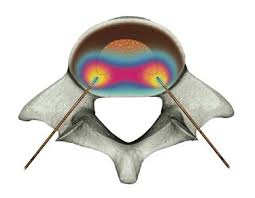Disc Biacuplasty
Disc Biacuplasty (Coolief Transdiscal)

Disc biacuplasty is a procedure that applies heat to the annulus of discs that separate the vertebra of the back with the goal of ablating the neurons that generate pain sensations. The procedure is designed to reduce chronic back pain caused by the intervertebral discs.
The procedure may destroy pain nerves without damaging nearby tissues, though evidence for this comes only from studies with cadavers. Testing has suggested it heats the desired area without damaging the dorsal root ganglia or spinal nerve roots, though the cells of the disc demonstrate histological changes.
Indications
Intervertebral discogenic pain is a major source of axial lower back pain. Thought to be related to nociceptors in the disrupted disc, discogenic pain that does not respond to conservative treatment can be frustratingly difficult to treat with few alternatives available. For intervertebral disc biacuplasty, bipolar probe placement straight into the disc creates large, reproducible lesion within a significant volume of the disc.
Procedure
For symptomatic patients suffering from discogenic pain, the COOLIEF TRANSDISCAL Cooled RF System uses a bipolar approach for intervertebral disc biacuplasty to create a large, reproducible lesion in the posterior and posterolateral annulus. Using revolutionary cooling technology, the dual COOLIEF Cooled RF Probes coagulate and deactivate nerves in a large volume of the posterior of the disc without risk of excessive heating of tissue.
- Electrodes are inserted straight inside the disc under fluoroscopy via an introducer for ease of placement, eliminating the challenge of navigating precise placement of a flexible catheter against or between the posterior annular wall.
- Impedance monitoring assists in identifying annulus and nucleus for confident placement.
- The COOLIEF TRANSDISCAL (Disc Biaclupasty) Cooled RF System enables the latest advancement in disc biacuplasty—placement of two additional monopolar lesions to help ensure denervation of the entire posterior of the disc (available with advanced generator model, V4).
- In a pilot trial, after six months follow up, most patients demonstrated substantial and statistically significant improvements in pain scores and functional capacity postprocedure throughout six months of observations. Patients who benefit from disc biacuplasty may avoid invasive surgical procedures.
The COOLIEF Cooled RF Pain Management System is a revolution in radiofrequency technology – giving physicians the power of targeted treatment for symptomatic patients, even in difficult to treat spine anatomy.
Risks and complications
- Bleeding or bruising at the needle insertion site
- Infection
- Nerve Injury
- Aggravation of pain
Credits & Sources:
- https://avanospainmanagement.com/solutions/chronic-pain/transdiscal/
- Kapural, Leonardo; Mekhail, N; Kapural, M; Hicks, D. “Histological and temperature studies of a novel transdiscal heating system in human cadaver discs”. unpublished conference abstract. San Francisco. Retrieved 2007-12-06.
- “New radiofrequency technique reduces disc pain with quick recovery time”. American College of Radiology. Archived from the original on 2012-02-06. Retrieved 2007-12-06.
- Kapural L, Mekhail N (2007). “Novel intradiscal biacuplasty (IDB) for the treatment of lumbar discogenic pain”. Pain Pract. 7 (2): 130–4. doi:10.1111/j.1533-2500.2007.00120.x. PMID 17559482.
- Petersohn, J; Conquergood, LR; Leung, M (2007-03-09). “Acute histologic effects and thermal distribution profile of disc biacuplasty using a novel water-cooled bipolar electrode system in an in vivo porcine model”. Pain Medicine. 9 (1): 26–32. doi:10.1111/j.1526-4637.2006.00293.x. PMID 18254764.


